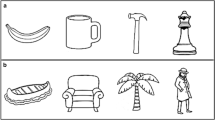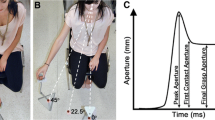Abstract
The role of visual information and the precise nature of the representations used in the control of prehension movements has frequently been studied by having subjects reach for target objects in the absence of visual information. Such manipulations have often been described as preventing visual feedback; however, they also impose a working memory load not found in prehension movements with normal vision. In this study we examined the relationship between working memory and visuospatial attention using a prehension task. In this study six healthy, right-handed adult subjects reached for a wooden block under conditions of normal vision, or else with their eyes closed having first observed the placement of the target. Furthermore, the role of visuospatial attention was examined by studying the effect, on transport and grasp kinematics, of placing task-irrelevant “flanker” objects (a wooden cylinder) within the visual field on a proportion of trials. Our results clearly demonstrated that the position of flankers produced clear interference effects on both transport and grasp kinematics. Furthermore, interference effects were significantly greater when subjects reached to the remembered location of the target (i.e., with eyes closed). The finding that the position of flanker objects influences both transport and grasp components of the prehension movement is taken as support for the view that these components may not be independently computed and that subjects may prepare a coordinated movement in which both transport and grasp are specifically adapted to the task in hand. The finding that flanker effects occur primarily when reaching to the remembered location of the target object is interpreted as supporting the view that attentional processes do not work efficiently on working memory representations.
Similar content being viewed by others
References
Athenes S, Wing AM (1989) Knowledge-directed coordination in reaching for objects in the environment. In: Wallace SA (eds) Perspectives on the coordination of movement. North-Holland, Amsterdam
Carnahan H, Goodale MA, Marteniuk RG (1993) Grasping versus pointing and the differential use of visual feedback. Human Movement Science 12: 219–234
Castiello U, Bennett KMB, Mucignat C (1993) The reach to grasp of blind subjects. Exp Brain Res 96: 152–162
Chieffi S, Gentilucci M, Allport A, Sasso E, Rizzolatti G (1993) Study of selective reaching and grasping in a patient with unilateral parietal lesion: dissociated effects of residual spatial neglect. Brain 116: 1119–1137
Crawford TJ, Henderson L, Kennard C (1989) Abnormalities of non-visually guided eye movements in Parkinson's disease. Brain 112: 1573–1586
Funahashi S, Bruce CJ, Goldman-Rakic PS (1990) Visuospatial coding in primate prefrontal neurons revealed by oculomotor paradigms. J Neurophysiol 63 (4): 814–831
Goldman-Rakic PS (1987) Circuitry of primate prefrontal cortex and regulation of behavior by representational memory. In: Plum F, Mountcastle V (eds) Higher functions of the brain. (Handbook of physiology, sect 1, The nervous system, vol V). American Physiological Society, Bethesda
Jackson SR, Marrocco R, Posner MI (1994) Networks of anatomical areas controlling visuospatial attention. Neural Networks Vol 7, Nos 6/7, pp 925–944
Jakobson L, Goodale MA (1991) Factors affecting higher-order movement planning: a kinematic analysis of human prehension. Exp Brain Res 86: 199–208
Jeannerod M (1984) The timing of natural prehension movements. J Mot Behav 16: 235–254
Lueck CJ, Crawford TJ, Henderson L, Van Gisbergen JAM, Duysens J, Kennard C (1992) Saccadic eye movements in Parkinson's disease. II. Remembered saccades — towards a unified hypothesis? Q J Exp Psychol 45A (2): 211–233
Rizzolatti G, Gentilucci M (1988) Motor and visual-motor functions of the premotor cortex. In: Rakic P, Singer W (eds) Neurobiology of neocortex. Wiley, New York
Rizzolatti G, Riggio L, Sheliga BM (1993) Space and selective attention. In: Moscowilch M, Umitta C (eds) Attention and performance XV. Erlbaum, Hillsdale, N.J.
Scheirman GL, Cheetham PJ (1990) Motion measurement using the Peak Performance Technologies System. Paper presented at the World Congress of Biomechanics, September 1990
Servos P, Goodale MA (1994) Binocular vision and the on-line control of human prehension. Exp Brain Res 98: 119–127
Sivak B, MacKenzie CL (1990) Integration of visual information and motor output in reaching and grasping: the contributions of peripheral and central vision. Neuropsychologia 28(10): 1095–1116
Tipper SP, Lortie C, Baylis GC (1992) Selective reaching: Evidence for action-centred attention. J Exp Psychol Hum Percept Perform 18: 891–905
Wing AM, Turton A, Fraser C (1986) Grasp size and accuracy of approach in reaching. J Mot Behav 18: 245–260
Author information
Authors and Affiliations
Rights and permissions
About this article
Cite this article
Jackson, S.R., Jackson, G.M. & Rosicky, J. Are non-relevant objects represented in working memory? The effect of non-target objects on reach and grasp kinematics. Exp Brain Res 102, 519–530 (1995). https://doi.org/10.1007/BF00230656
Received:
Accepted:
Issue Date:
DOI: https://doi.org/10.1007/BF00230656




